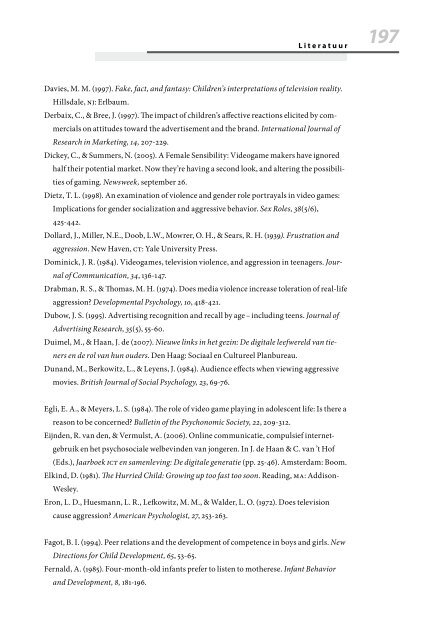Download PDF: Beeldschermkinderen - Kijkwijzer
Download PDF: Beeldschermkinderen - Kijkwijzer
Download PDF: Beeldschermkinderen - Kijkwijzer
You also want an ePaper? Increase the reach of your titles
YUMPU automatically turns print PDFs into web optimized ePapers that Google loves.
Literatuur<br />
Davies, M. M. (1997). Fake, fact, and fantasy: Children’s interpretations of television reality.<br />
Hillsdale, NJ: Erlbaum.<br />
Derbaix, C., & Bree, J. (1997). The impact of children’s affective reactions elicited by com-<br />
mercials on attitudes toward the advertisement and the brand. International Journal of<br />
Research in Marketing, 14, 207-229.<br />
Dickey, C., & Summers, N. (2005). A Female Sensibility: Videogame makers have ignored<br />
half their potential market. Now they’re having a second look, and altering the possibili-<br />
ties of gaming. Newsweek, september 26.<br />
Dietz, T. L. (1998). An examination of violence and gender role portrayals in video games:<br />
Implications for gender socialization and aggressive behavior. Sex Roles, 38(5/6),<br />
425-442.<br />
Dollard, J., Miller, N.E., Doob, L.W., Mowrer, O. H., & Sears, R. H. (1939). Frustration and<br />
aggression. New Haven, CT: Yale University Press.<br />
Dominick, J. R. (1984). Videogames, television violence, and aggression in teenagers. Jour-<br />
nal of Communication, 34, 136-147.<br />
Drabman, R. S., & Thomas, M. H. (1974). Does media violence increase toleration of real-life<br />
aggression? Developmental Psychology, 10, 418-421.<br />
Dubow, J. S. (1995). Advertising recognition and recall by age – including teens. Journal of<br />
Advertising Research, 35(5), 55-60.<br />
Duimel, M., & Haan, J. de (2007). Nieuwe links in het gezin: De digitale leefwereld van tie-<br />
ners en de rol van hun ouders. Den Haag: Sociaal en Cultureel Planbureau.<br />
Dunand, M., Berkowitz, L., & Leyens, J. (1984). Audience effects when viewing aggressive<br />
movies. British Journal of Social Psychology, 23, 69-76.<br />
Egli, E. A., & Meyers, L. S. (1984). The role of video game playing in adolescent life: Is there a<br />
reason to be concerned? Bulletin of the Psychonomic Society, 22, 209-312.<br />
Eijnden, R. van den, & Vermulst, A. (2006). Online communicatie, compulsief internet-<br />
gebruik en het psychosociale welbevinden van jongeren. In J. de Haan & C. van ’t Hof<br />
(Eds.), Jaarboek ICT en samenleving: De digitale generatie (pp. 25-46). Amsterdam: Boom.<br />
Elkind, D. (1981). The Hurried Child: Growing up too fast too soon. Reading, MA: Addison-<br />
Wesley.<br />
Eron, L. D., Huesmann, L. R., Lefkowitz, M. M., & Walder, L. O. (1972). Does television<br />
cause aggression? American Psychologist, 27, 253-263.<br />
Fagot, B. I. (1994). Peer relations and the development of competence in boys and girls. New<br />
Directions for Child Development, 65, 53-65.<br />
Fernald, A. (1985). Four-month-old infants prefer to listen to motherese. Infant Behavior<br />
and Development, 8, 181-196.<br />
197







